There are many possible causes for white tongue, and in some cases, it comes with an unpleasant odor and mouth dryness. To get rid of it, sometimes you just need to brush your teeth. But what should you do if that doesn’t help?

What white tongue is
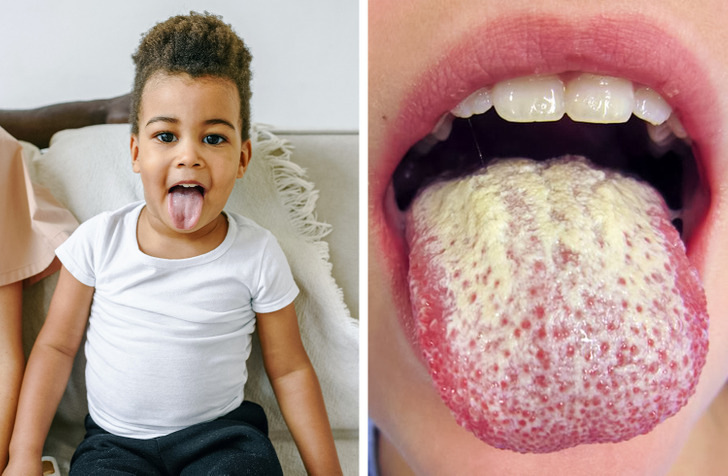
The white film may cover the entire tongue, part of it, or appear as spots. At the same time, an unpleasant odor and taste in the mouth may appear. It looks as if there are small white hairs on the tongue’s surface. In fact, they are buds covered with organic particles, bacteria, and dead cells.
White plaque on the tongue (which can also be yellow) may appear for different reasons, like due to irritation or because of an infection. It usually disappears after several days. If the situation doesn’t change for several weeks, and it’s painful to eat and talk, it’s best to see a doctor.
It’s important to note that the plaque may not only be white. While a pink tongue is normal, a brown tongue means the person drinks too much coffee or tea. A yellow tongue means there’s something wrong with the liver, and a red tongue is a sign that the person lacks vitamin B.
Why the tongue becomes white
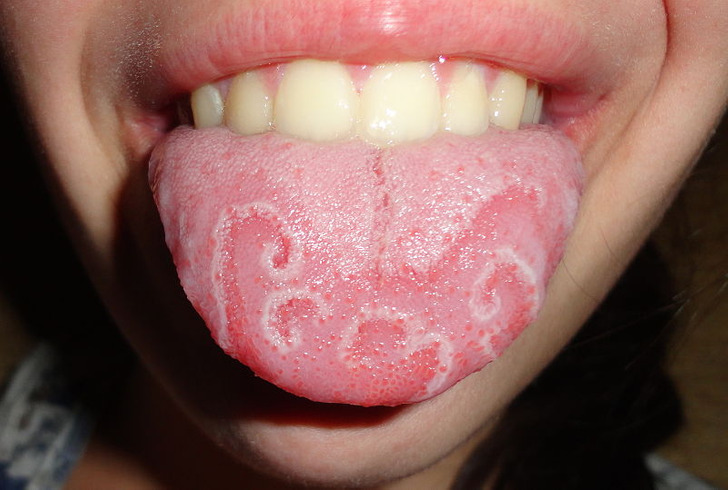
Usually, the tongue becomes white due to bacteria, leftover bits of food, or dead cells that get stuck in between the buds. Because of this, the buds may increase in size or become inflamed. This is how white spots on the tongue’s surface appear.
Sometimes, the plaque appears due to an illness. For example, the geographic tongue is also a condition where white spots appear on the tongue. It’s quite rare, and the causes are unknown, but the condition itself is often connected to eating foods that irritate the tongue. It may also be a reaction to stress, an illness, or hormonal changes.
Why white plaque appears on the tongue
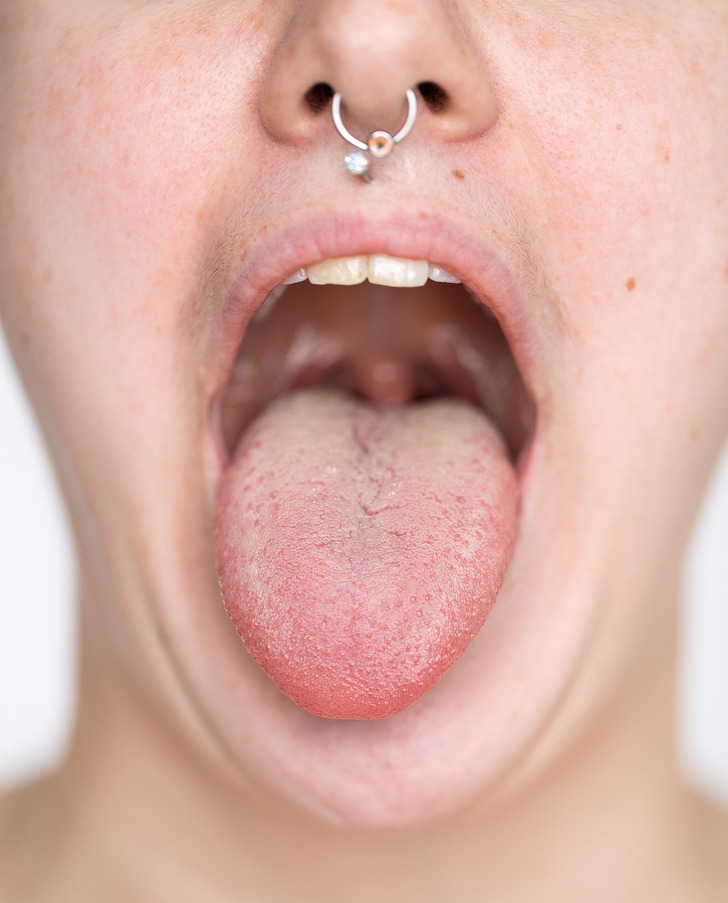
There are some things that make the appearance of white plaque on the tongue more probable:
- Age
- Taking antibiotics (white-yellow plaque appearing when there’s a fungal infection in the mouth)
- A diet that’s lacking enough fruits, vegetables, vitamin B12, and iron
- A weak immune system
- Bad mouth hygiene
- Dental prosthetics or other objects that can damage the tongue
- Dehydration and mouth dryness
What piercings have to do with white tongue
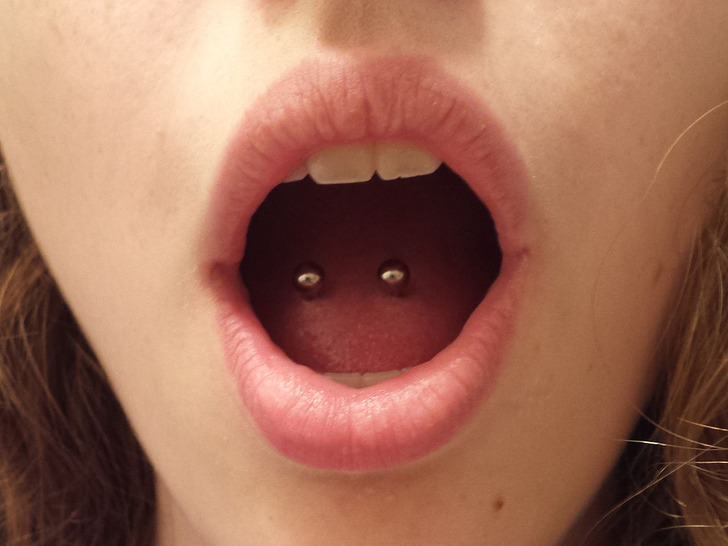
Right after piercing the tongue, there might be some white film present. This happens because the number of bacteria on the tongue increases, and it’s normal. Antibacterial mouthwash will help you get rid of it. Plus, there might be a ring around the piercings, which is normal too, and it means the tissue is healing.
If the plaque appears due to an injury (including piercings), the healing should take around 1.5 weeks. You should avoid irritants, such as hot, spicy, or sour foods and drinks.
How to get rid of white tongue at home
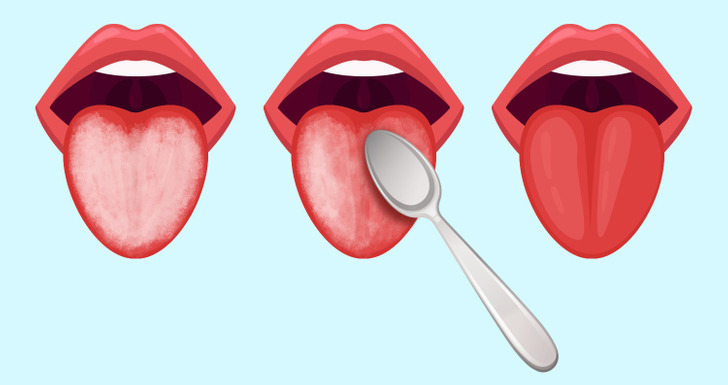
- Practice good mouth hygiene.
- Drink enough water.
- Brush your teeth using a soft toothbrush.
- Use a mild fluoride toothpaste — one that doesn’t contain sodium lauryl sulfate.
- Use fluoride mouthwash.
- Brush your tongue or use a tongue scraper to remove the white coating.
- Drink cold drinks through a straw.
- Avoid food and drinks that are spicy, salty, acidic, or very hot in temperature.
Who to talk to if you’re worried about your white tongue
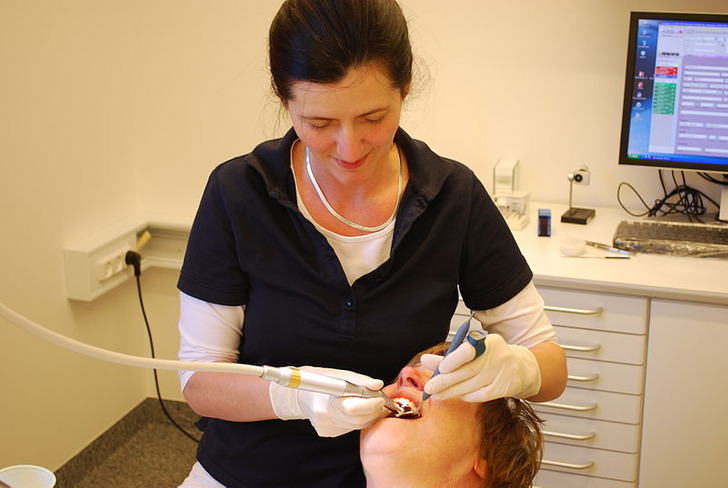
- Your dentist can help you remove the white film from the tongue and prescribe medications if needed.
- Your GP can diagnose the tongue, prescribe you certain medications and determine if the white tongue is an indicator of a more serious issue.
What do you do about white tongue?
Preview photo credit Genusfotografen (genusfotografen.se) & Wikimedia Sverige (wikimedia.se) / Wikimedia Commons, CC BY-SA 4.0, Martanopue / Wikimedia Commons, CC BY-SA 3.0
Melody Thomas Scott, the “The Young and the Restless” Nikki Newman since 1979, had a lot more tumultuous background than she would confess

Born in 1956 in Los Angeles, California, Thomas Scott made her acting debut in “Marnie” when she was just 13 years old.
She had a few small film and television appearances throughout the ensuing years, including parts starring Kirk Douglas and Clint Eastwood. She attended the University of Southern California to study piano performance as well.
Thomas Scott’s traumatic childhood past was not well known, despite her success in theater and television, which included multiple Emmy nominations, wins from Soap Opera Digest Awards, and Soap Opera Update Awards.

When she was a baby, her mother left her. Her grandmother took care of her instead of her mother, and regrettably, she did little to stop multiple individuals from abusing young Thomas Scott.
A few decades later, in 2020, Thomas Scott released a memoir titled “Always Young and Restless: My Life On and Off America’s #1 Daytime Drama,” which offered an open window into his life away from the spotlight.
At the age of four, Scott saw her grandmother being abused for the first time. Her grandmother was in the same room as Scott, but she did nothing to stop him from being abused all of Scott’s life.

She pursued a career as a child actor as an escape from the filth, vermin, and lack of protection in her family life. Her passion for acting was stoked when she discovered a sense of normalcy in her profession that she had never experienced before.
Scott moved out of her grandmother’s house when she reached twenty, despite the fact that her health was deteriorating. She realized that trying to convince her grandmother not to have let the abuse would not help; perhaps things would have turned out differently if her grandmother had not been so afraid to see a doctor. Scott overcame these setbacks and continued on despite having a horrible upbringing.
Scott reflected on the agony and adversity she had endured at the hands of her grandmother, a woman who was unable to forgive her for an incomprehensible occurrence. Scott’s grandma asked for forgiveness for years before she passed away, and Scott never made amends with her.
Scott was able to find the good in a difficult situation. She learned endurance, patience, and how to handle hardship as a result of her experience. She was unable to contact her grandma at times, though, because of her unreasonable actions.

Scott faced a difficult road ahead of her as a result; the author needed ten years to write a biography about these upsetting experiences. The project was in danger of being completely destroyed throughout the first few terrifying chapters, which only served to highlight how amazing the project’s completeness was after it was finished.
After shedding her grandmother’s name, Scott was able to go forward. In 1985, she wed Edward James Scott. When they celebrated their 20th wedding anniversary, they took the chance to reiterate their vows on “Entertainment Tonight” in front of their loved ones. The couple’s three adoptive children were named Jennifer, Alexandra, and Elizabeth.
According to Scott, having a child offered her a once-in-a-lifetime chance to make up for some of the wrongs done to her during her childhood. In an intentional effort to provide her girls a better upbringing than she had, Scott decided to assign them to different activities. She had the good fortune to watch them develop into mature, content adults with their own families as a result.
In an effort to help fans understand more about the woman who inspired TV character Nikki Newman, Scott shares her story. She also urges anyone in similar circumstances to seek help before it’s too late, emphasizing that abuse can happen to anyone, regardless of one’s financial standing.



Leave a Reply